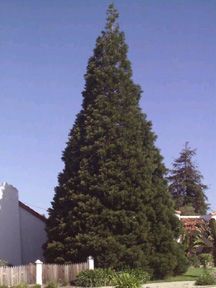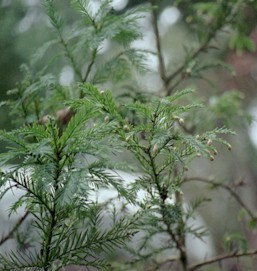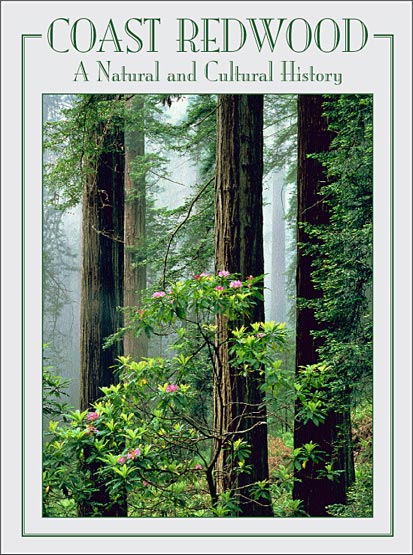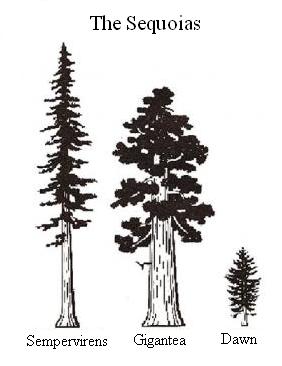|
|
|
Hansen's Northwest Native Plant Database |
|
|
|
Sequoia sempervirens (Coast Redwood)
|
|
||||||||||||||||||||||||||||||||||||||||||||||||||
|
Description: Sequoia sempervirens is an evergreen, long-lived-- living for up to 2,200 years, and this species includes the tallest trees on Earth, reaching up to 379.1 ft in height and 26 ft diameter at breast height. It is native to coastal California and the southwestern corner of Oregon within the United States. The coast redwoods are such rapid growers they easily beat out any competition to claim their space. They can grow up to 2 feet per year, blocking out light for the competitors. Remember, though, that over time they will get large--really large. The largest tree thus far was measured at 364 feet in height and 20 feet in diameter at breast height. The root system is composed of deep, wide spreading lateral roots with no taproot. The bark is up to 12 inches thick and quite fibrous. Redwood self-prunes well in dense stands; the base of the bole is strongly buttressed. Coast Redwood’s overall shape is conical, and branches are horizontal or slightly drooping. The bark is very thick, often up to 1 foot but very soft and fibrous. The inside is bright red to brownish but turns darker after exposure. Roots of this tree is very shallow and wide spreading. |
|||||||||||||||||||||||||||||||||||||||||||||||||||
|
The leaves are variable, about 1 inch long and flat on young trees and on shaded areas in the lower crown of old trees. On shoots in full sun the leaves are usually between ¼ to ½ inches long and more scale-like. The species has pollen and seed cones on the same plant. Habitat and Geographic Range: The majority of Coast Redwoods are found along the mountains of Pacific coastal regions of Oregon and California where the ocean generates a continuous flow of damp air. The most massive trees, and also the oldest, survive best in deep gullies where streams flow year-round and fog is dense. A combination of heavy seasonal rains, cool coastal air and regular fog in effect leaches required nutrients from the soil. Therefore Coast Redwood relies on the perfect biotic ambience and total natural recycling of trees after they fall to the earth. Optimum communities for Sequoia sempervirens include Douglas Fir (Pseudotsuga menziesii var. menziesii), Western Hemlock (Tsuga heterophylla ), Pacific Madrone (Arbutus menziesii), with under story ferns, sorrel, mosses and mushrooms. (Although Shrub Tanoak (Lithocarpus densiflorus), Pines and Douglas Fir (Pseudotsuga menziesii var. menziesii) tend to crowd out redwoods at higher elevations.) |
 |
||||||||||||||||||||||||||||||||||||||||||||||||||
|
The oldest documented Coast Redwood is about 2,200 years old. In the wild, it is not uncommon to see trees older than 600 years. Once thought to live forever, a common name at the turn of the century was "everlasting redwood." In fact, "sempervirens" means "ever green" or "everlasting," in Latin. Oddly, this nomenclature was unknown to those who named these giants. |
|||||||||||||||||||||||||||||||||||||||||||||||||||
|
Coast Redwood fossils from millions of years ago have been found in Europe and Asia. More recently, it has been planted in New Zealand, Australia, and Europe. Other areas of successful cultivation outside of the native range include Great Britain, Italy, Portugal, the Queen Charlotte Islands, middle elevations of Hawaii, a small area in central Mexico (Jilotepec) and the southeastern United States from eastern Texas to Maryland. Coast redwood trees were used in a display at Rockefeller Center and then given to Longhouse Reserve in East Hampton, Long Island, New York and these have now been living there for over 17 years and have survived temperatures to 2°F. Uses of Plant: Coast Redwood is one of the most valuable timber species in California, with 899,000 acres of redwood forest, all second growth, managed for timber production. Coast Redwood lumber is highly valued for its beauty, light weight, and resistance to decay. Its lack of resin makes it resistant to fire. |
 |
||||||||||||||||||||||||||||||||||||||||||||||||||
|
P. H. Shaughnessy, Chief Engineer of the San Francisco Fire Department wrote: In the recent great fire of San Francisco, that began April 18th, 1906, we succeeded in finally stopping it in nearly all directions where the unburned buildings were almost entirely of frame construction and if the exterior finish of these buildings had not been of redwood lumber, I am satisfied that the area of the burned district would have been greatly extended. |
|||||||||||||||||||||||||||||||||||||||||||||||||||
|
Beautiful bonsai Coast Redwood |
As development of railroads spread to the west coast, its famous resistance to decay lead to extensive use for railroad ties and trestles. When these are no longer necessary for train tracks, they find new use in gardens. The giant burls have been made into furniture or veneers. Propagation: Coast Redwoods bear seeds at 10–15 years of age. Though seed crops are large and frequent, only around 15% are viable. Seeds have wings and are small and light. It takes between 5,500 to 8,500 to weigh an ounce. Natural dispersal of seed by wind takes them only 200 to 400 feet from the parent. Of the relative few that actually germinate, the young seedlings grow quickly reaching an average of 65 feet in 20 years. These trees can also reproduce by layering of branches, sprouting from the root crown, or from branches of a fallen tree. |
||||||||||||||||||||||||||||||||||||||||||||||||||
|
There are two natural reproductive events that cause curious growth patterns in the wild:
|
|||||||||||||||||||||||||||||||||||||||||||||||||||
|
Redwoods are said to reproduce from woody tubers that develop on the tree beneath the soil line or within the lower 8 feet or so above the soil. These “burls” may detach from the parent and sprout a new tree. As an after-effect of flooding, the species puts out additional roots in the resulting silt deposits. Culture: Mulching and the use of ground covers increase survival of planted seedlings by reducing water evaporation and reducing competition from shrubs. Young seedlings are best shaded from full sun. Pests and Diseases: Coast Redwood’s thick bark and lack of low branches provides excellent protection from fire and insects. Possible damaging agents include insects, branch canker and heart rots. The insects associated with redwood cause no significant damage, but the branch canker girdles stems and branches, which can be especially harmful in plantations. Heart rots cause extensive cull in the redwood forest type. Wood rats girdle and strip the bark of redwood seedlings, and can seriously limit redwood regeneration. Where this is a problem, site preparation should include destroying wood rat nesting areas. Redwood is susceptible to damage from soil compaction in areas of heavy foot traffic. |
 Excellent resource for Coast Redwood by Michael Barbour, Sandy Lydon, Mark Borchert, Marjorie Popper, Valerie Whitworth and John Evarts. From Cachuma Press |
||||||||||||||||||||||||||||||||||||||||||||||||||
Historical
and Special interest:
|
|||||||||||||||||||||||||||||||||||||||||||||||||||
|
Origin of botanical name, original discovery info, etc.: With trees of this mass, determining the size is statistically exciting, especially within species where heights over 200 feet tall are not unusual. In fact, many are over 300 feet tall. The current tallest tree is Hyperion, measuring at 379.3 feet. It was found in 2006 in the Redwood National Park and earned the title of the world’s tallest living organism, taking this title from Stratosphere Giant in the Humboldt Redwoods State Park. Until falling in March 1991, another Humboldt denizen, Dyerville Giant, held that record. It was estimated to be 1,600 years old.
In theory, the maximum potential height of any tree is limited to between 400 and 425 feet. |
 |
||||||||||||||||||||||||||||||||||||||||||||||||||
|
In volume, the largest Coast Redwood is "Lost Monarch" with an estimated volume of 42,500 cubic feet, at 320 feet height and diameter of 26 feet at breast height. This phenomenon is in the Grove of Titans. In contrast, there are only 6 living Giant Sequoias that are larger than Lost Monarch. The Giant Sequoias are all shorter than Lost Monarch but their trunks are thicker. The largest known Giant Sequoia is General Sherman with a volume of 52,510 cubic feet. There was a potentially larger Coast Redwood with claimed volume of 63,350 cubic feet but this has not been verified and the tree in question was felled in 1926. |
|||||||||||||||||||||||||||||||||||||||||||||||||||
|
There are approximately fifty mutant redwoods that do not manufacture chlorophyll and are called 'albino' redwoods. Since they cannot produce their own food, they graft themselves parasitically to roots of normal trees. This type of mutation can occur in other conifers but no cases are known at this time. Largest trees As of 2009, the nine Coast Redwoods sporting claims as the largest in total wood volume measured in main trunk and stems. They are (in order of rank):
|
 |
||||||||||||||||||||||||||||||||||||||||||||||||||
|
As these are living trees, the largest and tallest can change at any time. Tallest trees These trees are over 367.5 feet tall as of 2010.
|
|||||||||||||||||||||||||||||||||||||||||||||||||||
|
Special Trees According to Redwood World, a group that keeps track of redwoods, there have been only two specimens of fallen sequoia in the UK: one was at Bank Hall in Bretherton, Lancashire; the second was at Leighton Hall, Powys, Wales. |
|||||||||||||||||||||||||||||||||||||||||||||||||||
|
Photos We Share!
|
|||||||||||||||||||||||||||||||||||||||||||||||||||
|